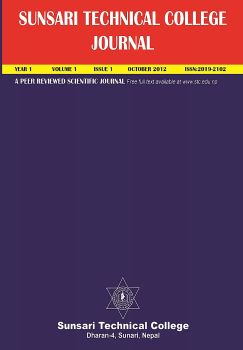Iodine status of school age children in the two hilly districts Dhankuta and Tehrathum of Eastern Nepal
DOI:
https://doi.org/10.3126/stcj.v1i1.7986Keywords:
Iodine statusAbstract
Background: Iodine deficiency remains a significant health problem in developing countries, including Nepal.
Objective: This study was conducted to measure the iodine status of school children in two districts Dhankuta and Tehrathum of Eastern Nepal by estimating median urinary iodine concentration (UIC) as a population parameter in the school children.
Materials and Methods: This cross-sectional study was conducted from August 2010 to July 2011 in school children (6-12 years of age) of two hilly districts of Eastern Nepal, Dhankuta and Tehrathum. A total of 154 school age children from the two districts were chosen for the study after obtaining written consent from their guardians and school authority. UIC was estimated in these school children by ammonium persulphate digestion microplate method.
Results: Among the school age children selected for the study median inter-quartile range (IQR) of urinary iodine in Dhankuta (n=63) and Tehrathum (n=91) districts were 214.04 (126.44; 323.0) μg/L and 252.34 (161.81; 301.63) μg/L. No significant differences were observed between the median UIC of these two districts (p=0.235). Among the school children in Dhankuta districts 2(3.2%) were severely deficient, 4(6.3%) were moderately deficient and 6(9.5%) were mildly deficient. In Tehrathum district 2(2.2%) were moderately deficient and 5(5.5%) were mildly deficient.
Conclusion: The present study showed improved iodine status with optimal levels of median urinary iodine concentration in the two districts, Dhankuta and Tehrathum of Eastern Nepal. Regular monitoring of population median urinary iodine concentration is recommended for sustainable optimal iodine nutrition.
DOI: http://dx.doi.org/10.3126/stcj.v1i1.7986
Sunsari Technical College Journal Vol.1(1) 2012 38-41




